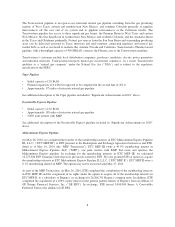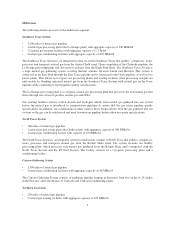Energy Transfer 2010 Annual Report Download - page 20
Download and view the complete annual report
Please find page 20 of the 2010 Energy Transfer annual report below. You can navigate through the pages in the report by either clicking on the pages listed below, or by using the keyword search tool below to find specific information within the annual report.handling in shipping and distribution. When the pressure is released or the temperature is increased, it is usable
as a flammable gas. Propane is naturally colorless and odorless. An odorant is added to allow its detection. Like
natural gas, propane is a clean burning fuel and is considered an environmentally preferred energy source.
Our propane business is largely seasonal and dependent upon weather conditions in our service areas.
Historically, approximately two-thirds of our retail propane volume and substantially all of our propane-related
operating income is attributable to sales during the six-month peak-heating season of October through March.
This generally results in higher operating revenues and net income in the propane segment during the period
from October through March of each year, and lower operating revenues and either net losses or lower net
income during the period from April through September of each year. Cash flow from operations is generally
greatest when customers pay for propane purchased during the six-month peak-heating season. Sales to
commercial and industrial customers are much less weather sensitive.
A substantial portion of our propane is used in the heating-sensitive residential and commercial markets causing
the temperatures in our areas of operations, particularly during the six-month peak-heating season, to have a
significant effect on the financial performance of our propane operations. In any given area, sustained warmer-
than-normal temperatures will tend to result in reduced propane use, while sustained colder-than-normal
temperatures will tend to result in greater propane use.
The retail propane segment’s gross profit margins are also affected by customer mix. Sales to residential
customers generate higher margins than sales to certain other customer groups, such as commercial or
agricultural customers. In addition, propane gross profit margins vary by geographical region. Accordingly, a
change in customer or geographic mix can affect propane gross profit without necessarily affecting total
revenues.
Competition
Propane competes with other sources of energy, some of which are less costly for equivalent energy value. We
compete for customers against suppliers of electricity, natural gas and fuel oil. Competition from alternative
energy sources has been increasing as a result of reduced utility regulation. Except for certain industrial and
commercial applications, propane is generally not competitive with natural gas in areas where natural gas
pipelines already exist because natural gas is a significantly less expensive source of energy than propane. The
gradual expansion of natural gas distribution systems in the United States has resulted in the availability of
natural gas in many areas that previously depended upon propane. Although the extension of natural gas
pipelines tends to displace propane distribution in areas affected, we believe that new opportunities for propane
sales arise as more geographically remote neighborhoods are developed. Even though propane is similar to fuel
oil in certain applications and market demand, propane and fuel oil compete to a lesser extent primarily because
of the cost to the customer to convert from one to another. According to industry publications, propane accounts
for 4.5% of household energy consumption in the United States.
In addition to competing with alternative energy sources, we compete with other companies engaged in the
distribution business of retail propane. Competition in the propane industry is highly fragmented and generally
occurs on a local basis with other large multi-state propane marketers, thousands of smaller local independent
marketers and farm cooperatives. Most of our customer service locations compete with five or more marketers or
distributors in their area of operations. Each retail distribution outlet operates in its own competitive environment
because retail marketers tend to locate in close proximity to customers. The typical retail distribution outlet
generally has an effective marketing radius of approximately 50 miles, although in certain rural areas the
marketing radius may be extended by satellite locations.
The ability to compete effectively further depends on the reliability of service, responsiveness to customers and
the ability to maintain competitive prices. We believe that our safety programs, policies and procedures are more
comprehensive than many of our smaller, independent competitors and give us a competitive advantage over
such retailers.
18
























